Curious about Actual Juniper Service Provider Routing & Switching Certification (JN0-664) Exam Questions?
Here are sample Juniper Service Provider Routing and Switching, Professional (JN0-664) Exam questions from real exam. You can get more Juniper Service Provider Routing & Switching Certification (JN0-664) Exam premium practice questions at TestInsights.
Exhibit.
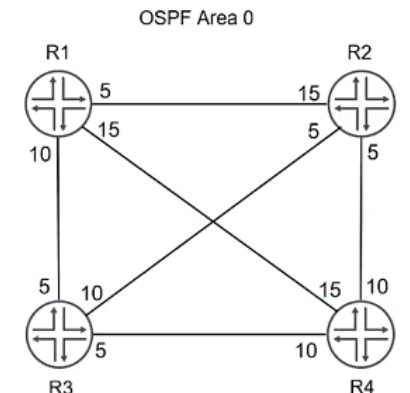
Referring to the exhibit, which path would traffic passing through R1 take to get to R4?
Correct : C
The OSPF cost is carried in the LSAs that are exchanged within an OSPF area. When a router calculates the cost to a destination it uses the cost of the exit interface of each router in the path to the destination.
Start a Discussions
Exhibit
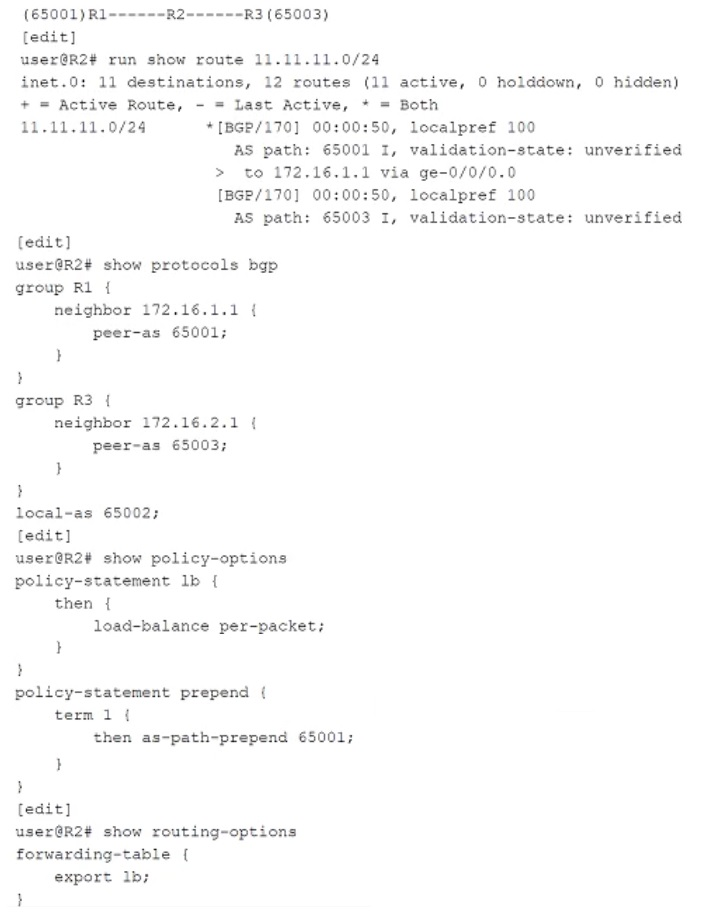
R2 is receiving the same route from R1 and R3. You must ensure that you can load balance traffic for that route.
Referring to the exhibit, which configuration change will allow load balancing?
Correct : C
Start a Discussions
Refer to the exhibit.
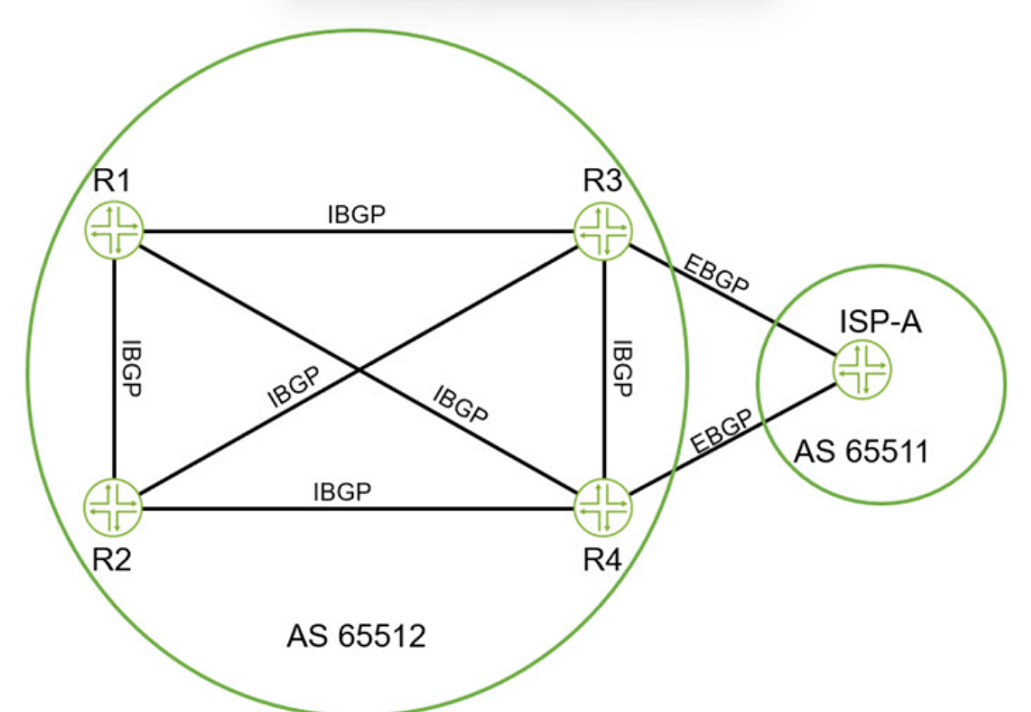
Click the Exhibit button.
Referring to the exhibit, which two statements are correct about BGP routes on R3 that are advertised to R1? (Choose two.)
Correct : C, D
In the exhibit, we see an internal BGP (iBGP) setup within AS 65512, and an external BGP (eBGP) connection between R3 and ISP-A (AS 65511). The questions focus on the behavior of BGP routes advertised from R3 to R1 within the same AS.
1. **BGP Next-Hop Attribute (Option A and D)**:
- In iBGP, the next-hop attribute is **not** changed when a route is advertised to another iBGP peer. This means that when R3 advertises a route to R1, it retains the original next-hop value as learned from the eBGP peer (ISP-A).
- Therefore, Option D is correct: 'By default, the next-hop value for these routes is not changed by R3 before being sent to R1.'
2. **BGP Attributes (Option B and C)**:
- BGP attributes such as local preference, AS-path, and others are crucial for BGP route selection. The local preference attribute is used within an AS to indicate the preferred path for outbound traffic.
- When R3 advertises BGP routes to R1, it includes the local preference value assigned to those routes. This value is not removed and is propagated within the iBGP mesh.
- Therefore, Option C is correct: 'By default, the BGP local-preference value that is assigned on R3 is advertised to R1.'
**Reference**:
- Juniper Networks documentation on BGP behavior provides detailed insights into the propagation of BGP attributes within iBGP and eBGP contexts. Specifically, the Junos OS documentation covers the default behavior of next-hop and local preference attributes in BGP configurations.
- Junos OS BGP Configuration Guide: [Junos OS BGP Configuration Guide](https://www.juniper.net/documentation/en_US/junos/topics/concept/bgp-overview.html)
- For a deeper understanding of BGP attributes and their default behaviors, the 'Juniper Networks Day One: Exploring BGP' book is an excellent resource.
Start a Discussions
Refer to the exhibit.
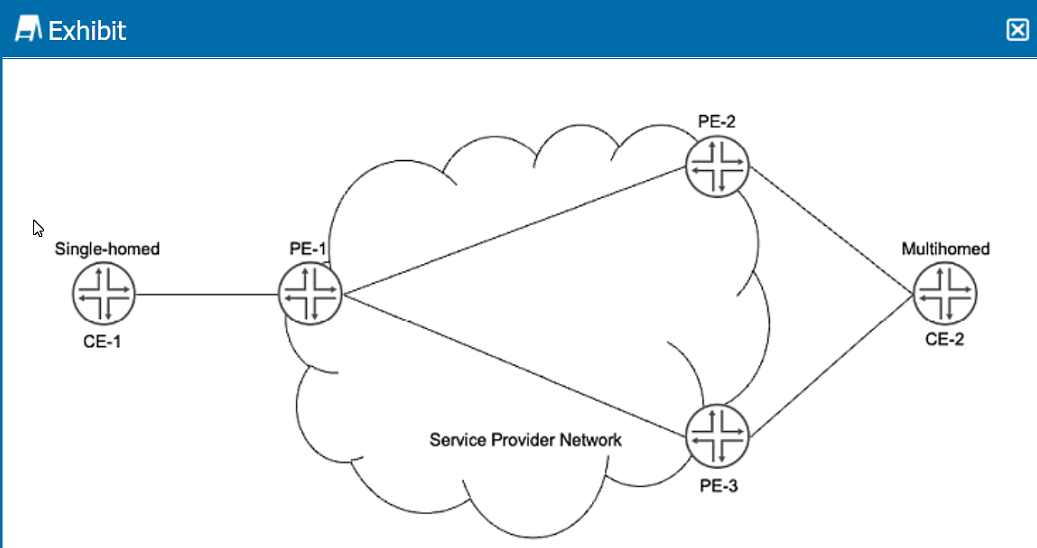
Click the Exhibit button.
You have an EVI implemented between PE-1, PE-2, and PE-3 to allow communication between CE-1 and CE-2. CE-2 receives unicast traffic from CE-1 on both links to PE-2 and
PE-3. When CE-1 sends broadcast traffic, CE-2 receives it on only one of the multihomed links.
Referring to the exhibit, which EVPN route type enables this behavior?
Correct : B
In the context of Ethernet VPN (EVPN) and the behavior described in the exhibit, it's essential to understand the different EVPN route types and their specific functionalities. Here, CE-2 is receiving unicast traffic on both of its multihomed links to PE-2 and PE-3, but broadcast traffic is received only on one of these links.
**Explanation of EVPN Route Types**:
1. **Type 1 (Ethernet Auto-Discovery Routes)**:
- These routes are used for auto-discovery of Ethernet segments and for advertising VLAN membership.
- They do not directly influence the behavior described in the question.
2. **Type 2 (MAC/IP Advertisement Routes)**:
- These routes are used to advertise MAC addresses and IP-to-MAC bindings within the EVPN.
- They handle unicast traffic forwarding and are crucial for populating the MAC address tables on the PE devices.
- While important, they do not explain the selective broadcast behavior.
3. **Type 3 (Inclusive Multicast Ethernet Tag Routes)**:
- These routes are used to build multicast distribution trees for delivering broadcast, unknown unicast, and multicast (BUM) traffic.
- They ensure that BUM traffic is sent only once per Ethernet segment, preventing duplicate frames from being sent to multihomed CEs.
- This aligns with the behavior described where CE-2 receives broadcast traffic on only one link to prevent duplication.
4. **Type 4 (Ethernet Segment Routes)**:
- These routes are used to advertise the presence of an Ethernet segment and are crucial for Designated Forwarder (DF) election processes in multihoming scenarios.
- While relevant to multihoming, they are not directly responsible for the selective broadcast behavior.
**Conclusion**:
The behavior described, where CE-2 receives broadcast traffic on only one of its multihomed links, is controlled by Type 3 routes. These routes are specifically designed to handle inclusive multicast and broadcast traffic efficiently in EVPN environments, ensuring that such traffic is not duplicated across multiple links to the same CE.
**Reference**:
- Juniper Networks EVPN Documentation: [EVPN Overview](https://www.juniper.net/documentation/en_US/junos/topics/concept/evpn-overview.html)
- RFC 7432, BGP MPLS-Based Ethernet VPN: [RFC 7432](https://tools.ietf.org/html/rfc7432) provides detailed descriptions of EVPN route types and their functions.
- Junos OS EVPN Configuration Guide: [Junos OS EVPN Configuration Guide](https://www.juniper.net/documentation/en_US/junos/topics/topic-map/evpn.html)
Start a Discussions
Refer to the exhibit.
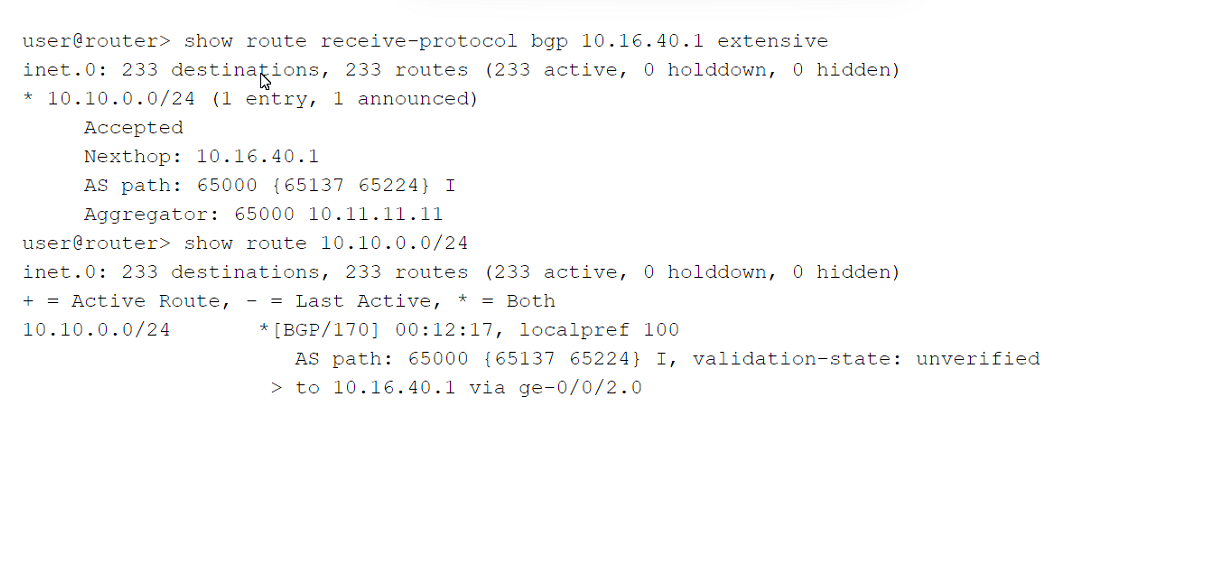
Click the Exhibit button.
You are troubleshooting an issue for a customer site that uses 10.10.0.0/24 in AS 65224, but you see another AS in the AS path.
Referring to the exhibit, what is the cause of the problem?
Correct : A
In the given exhibit, you are observing the BGP routing information for the prefix 10.10.0.0/24. The AS path for this prefix shows `65000 {65137 65224}`. To understand the issue, let's analyze each aspect of the information provided and the options given:
1. **AS Path Analysis**:
- The AS path attribute in BGP is a list of AS numbers that a route advertisement has traversed.
- In this case, the AS path `65000 {65137 65224}` indicates that the route to 10.10.0.0/24 has been advertised through AS 65000, which includes AS 65137 and AS 65224.
2. **Understanding AS Path Prepending**:
- AS path prepending is a technique used by AS administrators to artificially lengthen the AS path.
- By adding their own AS number multiple times into the AS path, they make a route less attractive to others.
- Here, AS 65000 is showing `65137` as part of its AS path, suggesting it might be prepending to manipulate routing decisions.
3. **Options Analysis**:
- **Option A**: 'AS 65000 is pre-pending AS 65137 to route advertisements.'
- This option suggests that AS 65000 is deliberately adding AS 65137 to the AS path. This matches the observed AS path, where AS 65000 has prepended `65137`.
- Therefore, this is the correct explanation.
- **Option B**: 'The local AS is receiving two equal cost routes to 10.10.0.0/24.'
- There is no evidence in the exhibit to support the presence of two equal-cost routes.
- **Option C**: 'The local AS is in the process of withdrawing the route from AS 65137.'
- Route withdrawal would not cause the AS path to include `65000 {65137 65224}`.
- **Option D**: 'AS 65137 is advertising the 10.10.0.0/24 prefix.'
- While AS 65137 is part of the path, it does not explain the presence of AS 65000 in the path, making this option incorrect.
**Conclusion**:
The AS path `65000 {65137 65224}` is indicative of AS 65000 prepending AS 65137. Therefore, the correct answer is:
**A. AS 65000 is pre-pending AS 65137 to route advertisements.**
**Reference**:
- Juniper Networks documentation on BGP AS path manipulation and prepending techniques.
- BGP Best Practices and Routing Policies: [Juniper Networks BGP Best Practices](https://www.juniper.net/documentation/en_US/junos/topics/concept/bgp-best-practices-routing-policies.html)
- RFC 4271, A Border Gateway Protocol 4 (BGP-4): [RFC 4271](https://tools.ietf.org/html/rfc4271) which describes the behavior and attributes of BGP, including AS path prepending.
Start a Discussions
Total 96 questions